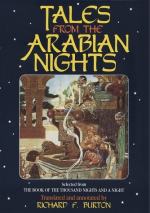[FN#229] Who evidently ignored or had forgotten the little matter of the concubine, so that incident was introduced by the story-teller for mere wantonness.
[FN#230] In text “Mazbuh"=slaughtered for food.
[FN#231] i.e. “I suffer from an acute attack of rheumatism”—a complaint common in even the hottest climates.
[FN#232] Needless to say that amongst Moslems, as amongst Christians, the Israelite medicine-man has always been a favourite, despite an injunction in the “Dinim” (Religious Considerations) of the famous Andalusian Yusuf Caro. This most fanatical work, much studied at Tiberias and Safet (where a printing-press was established in the xvith century) decides that a Jewish doctor called to attend a Goi (Gentile) too poor to pay him is bound to poison his patient—if he safely can.
[FN#233] Lit. “The-Bull-(Taur for Thaur or Saur)numbered-and-for-battle-day-lengthened.” In p.30 this charger is called, “The-bull-that-spurneth-danger-on-battle-day.” See vol. vi. 270 for a similar compound name, The-Ghul-who-eateth-man-we-pray-Allah-for-safety.
[FN#234] In text “Al-Jariyah radih,” the latter word being repeated in p.282, where it is Radih a P.N. [Here also I would take it for a P.N., for if it were adjective to “al-Jariyah” it should have the article.—St.]
[FN#235] The “Radif,” or back-rider, is common in Arabia, esp. on dromedaries when going to the Razzia: usually the crupper-man loads the matchlock and his comrade fires it.
[FN#236] The text has “thirty,” evidently a clerical error.
[FN#237] Arab. “Sakhtur” for “Shakhtur,” vol. vii. 362.
[FN#238] Doggerel fit only for the coffee-house.
[FN#239] In text “Ta’ayyun"=influence, especially by the “’Ayn,” or (Evil) Eye.
[FN#240] I have somewhat abridged the confession of the Princess, who carefully repeats every word known to the reader. This iteration is no objection in the case of a coffee-house audience to whom the tale is told bit by bit, but it is evidently unsuited for reading.
[FN#241] In text “Irham turham:” this is one of the few passive verbs still used in popular parlance.
[FN#242] This formula will be in future suppressed.
[FN#243] I spare my readers the full formula:—“Yusuf took it and brake the seal (fazza-hu) and read it and comprehended its contents and purport and significance: and, after perusing it,” etc. These forms, decies repetita, may go down with an Eastern audience, but would be intolerable in a Western volume. The absence of padding, however, reduces the story almost to a patchwork of doggerel rhymes, for neither I nor any man can “make a silk purse from a suille ear.”
[FN#244] Here again in full we have:—“He mounted the she-camel and fared and ceased not faring until he drew near to the Palace of Al-Hayfa, where he dismounted and concealed his dromedary within the same cave. Then he swam the stream until he had reached the Castle and here he landed and appeared before Al-Hayfa,” etc.




